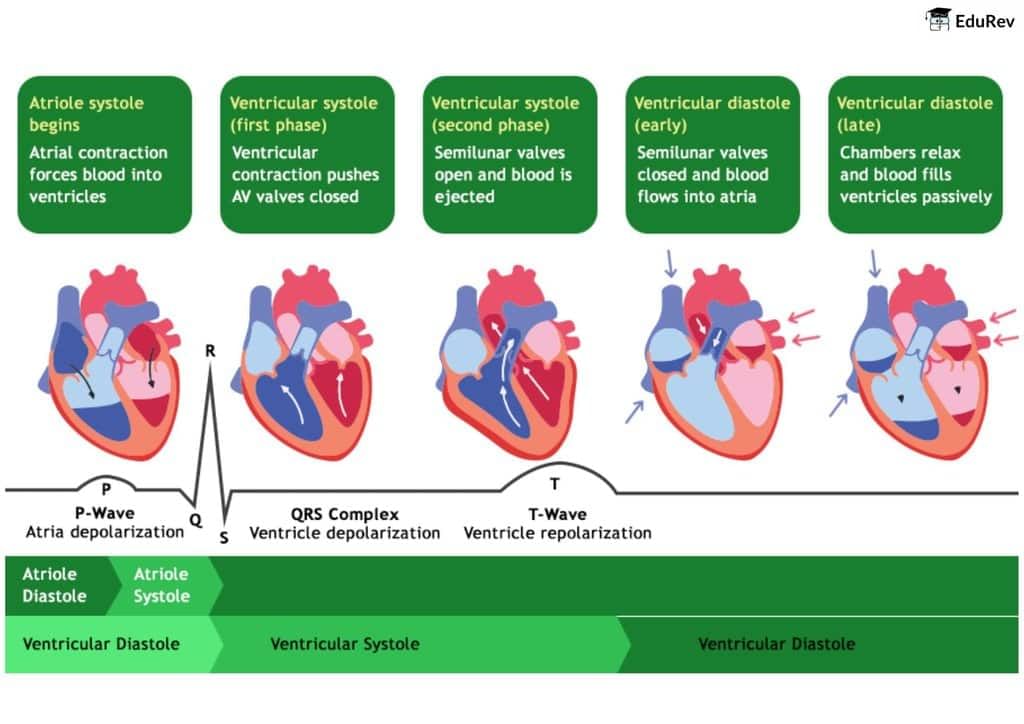NEET Exam > NEET Notes > Biology Class 11 > Poster: Cardiac cycle and ECG
Poster: Cardiac cycle and ECG | Biology Class 11 - NEET PDF Download

The document Poster: Cardiac cycle and ECG | Biology Class 11 - NEET is a part of the NEET Course Biology Class 11.
All you need of NEET at this link: NEET
|
183 videos|524 docs|136 tests
|
FAQs on Poster: Cardiac cycle and ECG - Biology Class 11 - NEET
| 1. What is the cardiac cycle and what are its main phases? |  |
Ans. The cardiac cycle refers to the sequence of events that occur during one complete heartbeat, including the contraction and relaxation of the heart muscles. It consists of two main phases: systole and diastole. Systole is the phase when the heart contracts, pumping blood out of the chambers, while diastole is the phase when the heart relaxes and fills with blood. Each cycle includes atrial systole, ventricular systole, and the subsequent relaxation phases.
| 2. How does an ECG (electrocardiogram) reflect the cardiac cycle? |  |
Ans. An ECG captures the electrical activity of the heart during the cardiac cycle. It displays waves corresponding to different phases: the P wave represents atrial depolarization (atrial contraction), the QRS complex represents ventricular depolarization (ventricular contraction), and the T wave reflects ventricular repolarization (ventricular relaxation). By analyzing these waves, healthcare professionals can assess the heart's rhythm and detect abnormalities.
| 3. What is the significance of understanding the cardiac cycle for NEET aspirants? |  |
Ans. Understanding the cardiac cycle is crucial for NEET aspirants as it forms a significant part of the physiology syllabus. Knowledge of the cardiac cycle helps in comprehending how the heart functions, the importance of blood circulation, and the relationship between electrical and mechanical activities of the heart. This understanding is fundamental for answering questions related to cardiovascular physiology and pathology in the exam.
| 4. What are common abnormalities that can be detected through an ECG related to the cardiac cycle? |  |
Ans. Common abnormalities detectable through an ECG include arrhythmias (irregular heartbeats), myocardial infarction (heart attack), and hypertrophy (thickening of heart walls). For example, a prolonged QRS complex may indicate a delay in ventricular conduction, while changes in the ST segment can suggest ischemia. Detecting these abnormalities is essential for diagnosing heart conditions and planning appropriate interventions.
| 5. How can the cardiac cycle be influenced by exercise and physiological conditions? |  |
Ans. The cardiac cycle can be influenced by factors such as exercise, stress, and physiological conditions. During exercise, heart rate increases, leading to shorter diastolic phases to maintain adequate blood flow and oxygen supply to muscles. Additionally, conditions like hypertension or heart disease can alter the normal rhythm and efficiency of the cardiac cycle, affecting overall cardiovascular health. Understanding these influences is important for both academic knowledge and practical applications in health sciences.
Related Searches
















